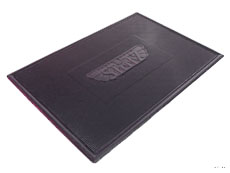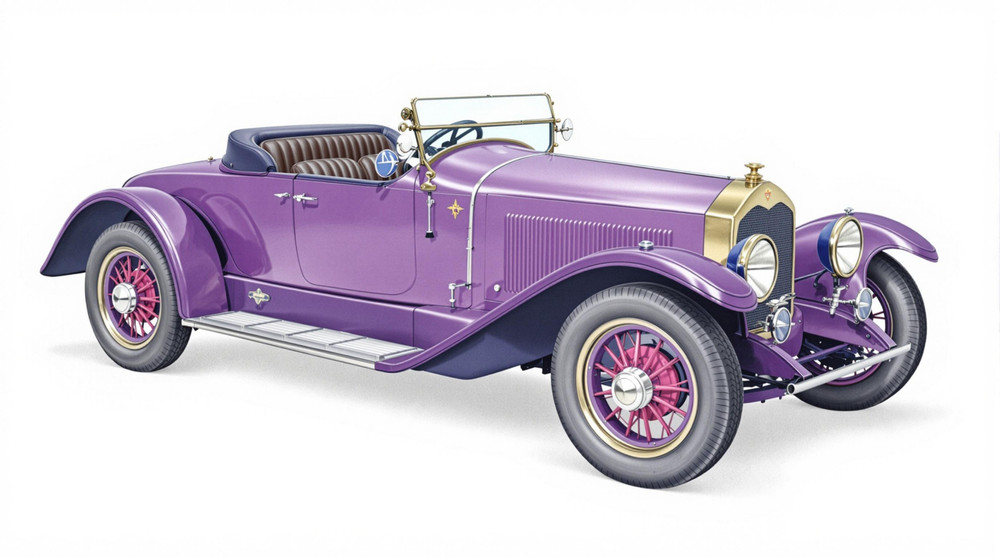Image of 1923 Stutz Speedway Four, Note: These illustrations use artistic license and may differ from actual historical models.
Performance Metrics
Fundamental Metrics
Emotional Appeal
MMP Rating
| Engine Specifications | |
|---|---|
| Engine: | Inline 4-cylinder engine |
| Displacement: | 360 cubic inches |
| Horsepower: | Estimated 80-90 HP |
| Torque: | Not available |
| Compression Ratio: | Not available |
| Ignition System: | Battery and coil |
| Cooling System: | Water-cooled |
| Performance Specifications | |
| 0-60 Time: | Not available |
| 1/4 Mile Time: | Not available |
| Top Speed: | 70 mph |
| Transmission and Drive | |
| Drive Type: | Rear-wheel drive |
| Transmission Type: | 3-speed manual |
| Fuel and Efficiency | |
| Fuel System Type: | Carburetor |
| MPG: | Not available |
| Dimensions and Brakes | |
| Brakes: | Mechanical drum brakes |
| Wheelbase: | 130 inches |
| Weight: | Estimated 3,200 lbs |
Note: Specifications for classic cars are given to the best of our ability, considering the limited and variant data available.
Unveiling the 1923 Stutz Speedway Four: A Testament to Automotive Heritage
The 1923 Stutz Speedway Four stands as a majestic testament to the ingenuity of early 20th-century automotive design. Born from the ambitious vision of Harry C. Stutz, this vehicle emerged from an era where cars transitioned from novelties to symbols of status and technological prowess. The Stutz Motor Company, known for its performance and quality, crafted this model during a time when the roar of engines began to echo the promise of modern America. A unique fact that car enthusiasts may find fascinating is that the Speedway Four was part of a lineage that included the acclaimed Stutz Bearcat, a car that had already etched its name in racing legend.
Design and Innovation: A Blend of Elegance and Engineering
The exterior of the 1923 Stutz Speedway Four exuded elegance with its elongated hood, gleaming chrome accents, and bold, upright grille—a design that commanded attention on every boulevard. The interior was a sanctuary of luxury, with high-quality leather upholstery and polished wood trim, reflecting the opulence expected by the discerning buyers of the day. Technologically, it boasted advancements like a powerful overhead valve (OHV) engine and a three-speed transmission that set it apart from many competitors. While color options were limited compared to today's standards, choices often included rich blues, deep blacks, and dark greens, with black being a popular choice for its timeless sophistication. The most iconic body style was undoubtedly the roadster, which perfectly encapsulated the spirit of freedom and excitement associated with early motoring.
Historical Significance: Paving the Way for Future Classics
The 1923 Stutz Speedway Four's impact on automotive design was profound. It helped cement the notion that cars could be both beautiful and mechanically advanced. Its OHV engine influenced future powertrain designs, proving that efficiency and performance could coexist harmoniously. This model stood out not just for its speed but also for its reliability—a combination that would inspire generations of carmakers.
Performance and Handling: Experiencing the Thrill of Vintage Motoring
In terms of performance, the Speedway Four's top speed was impressive for its time, capable of reaching speeds that allowed it to breeze past most other vehicles on the road. Acceleration figures are harder to come by in this era, but drivers reported brisk takeoffs indicative of its racing heritage. Handling was characterized by a solid yet responsive feel—drivers needed to be engaged with every turn of the wheel and every shift of the gearbox. Driving this car was an immersive experience; from the throaty rumble of its engine to the wind rushing past during open-top motoring—it was pure exhilaration.
Ownership Experience: More Than Just a Means to Travel
Owners of the 1923 Stutz Speedway Four typically reveled in its dual-purpose nature—it served as both a daily driver for some and as an eye-catching showpiece for others. Racing enthusiasts also prized these cars for their competitive edge on makeshift tracks across America. Maintenance required a hands-on approach; however, due to simpler mechanics compared to modern vehicles, many owners found joy in tinkering with their machines. Reliability was commendable for its age but finding parts today can be a quest in itself.
Fun Facts: The Speedway Four's Unique Place in History
A piece of trivia that adds to the allure of the Speedway Four is its connection to notable personalities or events; while specific records are scarce, any surviving models likely have storied pasts worth uncovering. Criticisms at the time often centered around fuel consumption—a common trade-off for performance vehicles even today.
Collector's Information: A Coveted Piece of Automotive Royalty
For collectors, a 1923 Stutz Speedway Four is akin to finding treasure. With production numbers not precisely known but undoubtedly low, surviving examples are rare jewels in any collection. As for value range, pristine models can fetch considerable sums well into six figures—reflecting their desirability among classic car aficionados. The market trend has generally seen an appreciation in value over time as these vehicles become scarcer and more sought after.
Conclusion: Celebrating an Iconic Masterpiece
The 1923 Stutz Speedway Four is more than just an antique; it's a rolling piece of art that encapsulates an era when cars began shaping society. Its blend of style, innovation, and performance makes it an enduring icon in automotive history—a true classic that continues to captivate enthusiasts nearly a century later.
1923 Stutz Speedway Four Catalog of Parts
 1923 Stutz Speedway Four Accessory Floor Mat - 12"X17"-AC 41Accessory Floor Mat - made of high quality black rubber with molded original emblem. Also designed to be sewn into new carpets. 12"X17", Each
1923 Stutz Speedway Four Accessory Floor Mat - 12"X17"-AC 41Accessory Floor Mat - made of high quality black rubber with molded original emblem. Also designed to be sewn into new carpets. 12"X17", EachWhy Choose Metro?
For over 100 years, Metro Moulded Parts has been the pinnacle of quality in classic car restoration parts. Our commitment to precision and authenticity in every component ensures a perfect fit and an OEM-level appearance.
- Expert Craftsmanship & Quality: Each part is a testament to our dedication to reliability and perfection, crafted from original designs and thoroughly tested.
- Advanced Technology: We use cutting-edge techniques to create flawless, long-lasting parts that surpass others in performance.
- SuperSoft Sponge – The Ultimate Door Seal: Not only are our door seals 30% softer than competitors', but they're also guaranteed to never leak. They effectively reduce wind and road noise, enhancing your classic car's comfort and driving experience.
- Proudly American: Our parts are a product of American craftsmanship, made in the USA with a spirit of excellence and heritage.
- Unrivaled Warranty: We back our products with a 30-year industry-leading warranty, a testament to our confidence in their quality.
Join us in preserving the legacy of classic cars with parts that are crafted for perfection, not just made.

